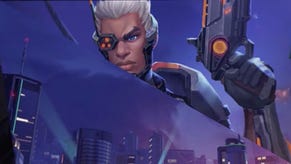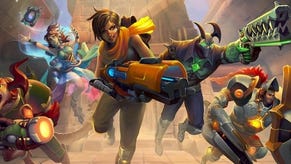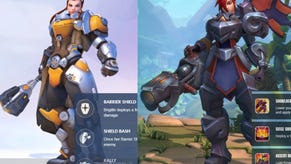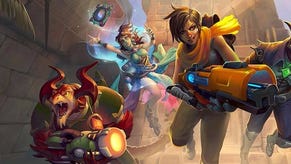Paladins runs at 60fps on Switch and it's superb
Resolution takes a hit but this is close to the complete package.
Paladins on Switch is a current-gen port that offers a genuine surprise: it's a true 60fps rendition of a title that - perhaps unfairly - has been overshadowed by Overwatch. But with Blizzard's own shooter missing from Switch's library, Paladins has a great chance to shine here, and shine it does: developer Hi-Rez Studios squeezes almost all of the full console experience onto Nintendo's hybrid. It comes fully featured with all characters and maps and as a result, cross-play with Xbox One works brilliantly. 60fps support for a current-gen port is far from the norm on Switch, so what are the trades and do they have any impact on the quality of the gameplay?
With the docked Switch hooked up to your HDTV, gameplay is as tight and responsive as you could possibly hope for - a 60fps game with v-sync that tackles even the busiest scenes without too much trouble. Yes, there are some blips and hiccups along the way - a state of affairs that doesn't really trouble the PS4 or Xbox One versions - but in general, performance is comparable. The small stutters are curious though. They don't manifest in offline practice matches, suggesting that the Switch's background processing of network code may be the cause.
While a complete 60fps lock might be off the table, the smooth performance level delivered to Switch users for an online shooter is clearly a boon. True, it dispenses with visual quality to maintain that frame-rate, but the pay-off is clear: Switch players actually have close to level footing with Xbox One users in cross-play, who populate the same online servers. It's ideal for anyone picking Paladins up hoping for a fair chance in deathmatch or siege games. By comparison, it's the opposite situation for Fortnite, which leaves Switch users running at half the frame-rate of cross-play rivals.
Predictably, the principal price in hitting 60 frames per second comes from resolution. In docked play, Paladins uses dynamic resolution scaling (DRS), maxing out at 1600x900 resolution in the lightest scenes. In practice though, a majority of battles veer closer to 1280x720 - and the absolute lowest figure we've seen is 1008x567. This worst case expectedly kicks in at peak GPU load, with all 10 characters on-screen in a deathmatch firing off their abilities, and also, momentarily just after respawning to a new spot.
While the changes in pixel count are certainly visible, it doesn't get in the way of the experience. Changes in resolution are marked by a sudden burst of pixel crawl, followed by a touch more blur to long-distance detail - but as a compromise for keeping 60fps almost always locked in, it's worth it. This dynamic setup follows in the footsteps of the other console versions, and for perspective, a standard Xbox One runs at a dynamic 1080p with drops to 1728x972. Switch pushes a less clear image of course, but thanks to Paladins' bright, colourful art style - which often avoids noisy, high detailed textures - it gets away with it more than most games could.
And then there's the handheld mode. When playing Switch portably, it still runs its ARM Cortex-A57 CPU cluster at the same 1GHz as the docked configuration, meaning that game logic and netcode run identically. GPU frequencies tumble though, meaning that the DRS scaler now tops out at the portable screen's native 720p. However, this is the maximum value, and resolution suffers greatly in standard play. To maintain 60fps in portable mode, the hit to image quality is often significant, going down to around 672x378 - or 52.5 per cent on each axis. Sadly, this is where the trade-off for smooth playback starts to affect playability in another way. At 378p it can look rather like a compressed YouTube video, and for long-range aiming it starts to get in the way. In common with all versions, the player still has auto-aim to help with targeting, but the reality is you're left with a Vaseline-like smear to work with once all players fill the screen.
It's manageable and still technically impressive given Switch's reduced GPU power off the dock. But here at least, the price of 60fps is high, and while this is still preferable, it makes you consider how a 30fps mode could look and whether a resolution/performance selection option might have been a worthwhile addition. Fortunately it does all pay off: Switch's performance in handheld mode is every bit as solid as when played under the TV. The occasional hitches and stutters are still a nuisance, but the average run of gameplay is still sustained at 60fps. It's all very impressive.
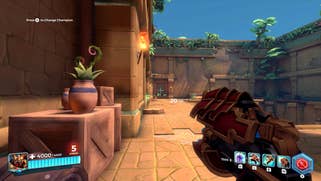
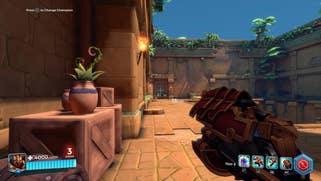
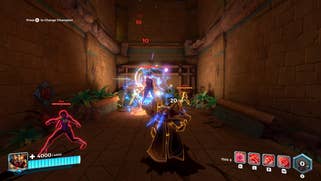
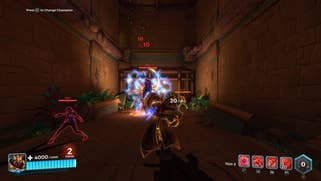


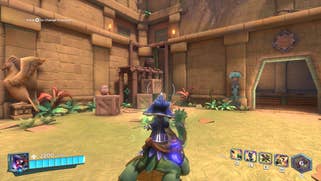
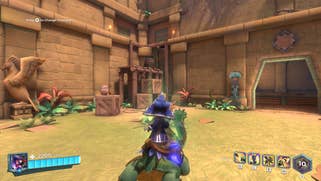




But is resolution the only casualty in Paladins' transition to Switch? This is an ambitious port in several respects, after all. For example, it's an Unreal Engine 3 title on a system where Epic doesn't support its development - similar to the Switch port of Rocket League. To get a handle on how Hi-Rez may have massaged the existing game onto Nintendo's hybrid, we stacked up the new release against the Xbox One X version - which is effectively the top-tier Paladins console experience. As you might expect, Microsoft's six teraflop monster runs with all the graphical bells and whistles in place, with a dynamic 4K resolution. It's actually surprising to find that Switch doesn't look too dissimilar in side-by-side shots. The fact is that it draws on the same effective, simple assets, all of which translate easily to Switch's more restrictive 4GB of RAM.
With that being said though, there are differences. The Switch port dials back settings in several areas, but by such small degrees you might not notice outside of direct head-to-head comparisons. Texture quality is broadly the same on characters, but environments take a hit in spots and with weaker texture filtering too. The only aspect that truly stands out here is more aggressive texture flickering during sharp turns, causing white flashes on corners as the texture loads in. It's an artefact even Xbox One X suffers from, but it's more prevalent on Nintendo's machine. [UPDATE: We understand this is a factor of UE3's occlusion culling system which has a certain degree of latency on new objects that enter the frame.]
Inevitably, you also miss out on some of Unreal Engine 3's higher-end features: lights shafts are removed from Switch for example - much like Fortnite. It rarely appears in the Xbox One X version, but it's a nice stylistic flourish for the game when you do catch it - and the effect is entirely missing on Switch to squeeze out the best performance possible. Elsewhere, shadow maps also suffer in the transition, but never to a radical extent - the definition is only marginally muddied. And while ambient occlusion is still included in the package, it's a variation of what we have on X.
These are all nitpicks though, to be fair. The Switch version runs at lower settings, but the gradients of change there are too small to register. The fact it's operating at 60fps both in docked and portable mode makes this a surprise victory for the console - and by extension, it's a remarkable port simply for the way it plays. There are frustrations, of course. The online hiccups are an occasional rough point, and the menus aren't as responsive as they could be. We also suffered a software lock-up, taking the Switch to its front-end menu just after matchmaking finished - but thankfully this has been a one-off case.
Overall, there's a lot to respect in how Paladins is represented on Switch. Hi-Rez has accomplished one of the closest matches to the other versions available, crafting a 60fps title where online competition with Xbox One players feels balanced and fair. It's a game where the visual hit doesn't strike you as a major drawback: resolution is the only key differentiator, and it can be something of an issue sometimes in portable play. However, by and large, Paladins holds up compared to the other console versions and it's well worth checking out.



